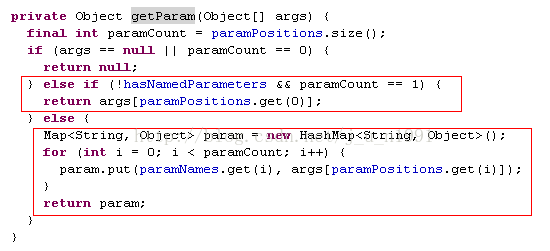在sql開發過程中,動態構建in集合條件查詢是比較常見的用法,在mybatis中提供了foreach功能,該功能比較強大,它允許你指定一個集合,聲明集合項和索引變量,它們可以用在元素體內。它也允許你指定開放和關閉的字符串,在迭代之間放置分隔符。這個元素是很智能的,它不會偶然地附加多余的分隔符。
下面是一個演示示例:
|
1
2
3
4
5
6
7
8
|
<select id="findbyidsmap" resultmap="baseresultmap"> select <include refid="base_column_list" /> open="(" separator="," close=")"> #{item} </foreach> </select> |
但由于官方文檔對這塊的使用,描述的比較簡短,細節上也被忽略掉了(可能是開源項目文檔一貫的問題吧),也使用不少同學在使用中遇到了問題。特別是foreach這個函數中,collection屬性做什么用,有什么注意事項。由于文檔不全,這塊只能通過源代碼剖析的方式來分析一下各個屬性的相關要求。
collection屬性的用途是接收輸入的數組或是list接口實現。但對于其名稱的要求,mybatis在實現中還是有點不好理解的,所以需要特別注意這一點。
下面開始分析源代碼(筆記使用的是mybatis 3.0.5版本)
先找到mybatis執行sql配置解析的入口
mappermethod.java類中 public object execute(object[] args) 該方法是執行的入口.
針對in集合查詢,對應用就是 selectforlist或selctformap方法。

但不管調用哪個方法,都會對原來jdk傳入的參數 object[]類型,通過 getparam方法轉換成一個object,那這個方法是做什么的呢?分析源碼如下:

上圖中標紅的兩處,很驚訝的發現,一個參數與多個參數的處理方式是不同的(后續很多同學遇到的問題,就有一大部分出自這個地方)。如果參數個數大于一個,則會被封裝成map, key值如果使用了mybatis的 param注解,則會使用該key值,否則默認統一使用數據序號,從1開始。這個問題先記下,繼續分析代碼,接下來如果是selectforlist操作(其它操作就對應用相應方法),會調用defaultsqlsession的public list selectlist(string statement, object parameter, rowbounds rowbounds) 方法
又一個發現,見源代碼如下:

上圖標紅部分,對參數又做了一次封裝,我們看一下代碼

現在有點清楚了,如果參數類型是list,則必須在collecion中指定為list, 如果是數據組,則必須在collection屬性中指定為 array.
現在就問題就比較清楚了,如果是一個參數的話,collection的值取決于你的參數類型。
如果是多個值的話,除非使用注解param指定,否則都是數字開頭,所以在collection中指定什么值都是無用的。下圖是debug顯示結果。

針對上面分析的結果,下面給出了一個使用的解決方案,希望對大家對幫助。
在使用這個功能是需要特別注意以下規則:
1. 當查詢的參數只有一個時
|
1
2
3
4
5
6
7
8
9
10
11
12
13
14
15
16
17
18
19
20
|
findbyids(list<long> ids)1.a 如果參數的類型是list, 則在使用時,collection屬性要必須指定為 list <select id="findbyidsmap" resultmap="baseresultmap"> select <include refid="base_column_list" /> from jria where id in <foreach item="item" index="index" collection="list" open="(" separator="," close=")"> #{item} </foreach> </select> findbyids(long[] ids) 1.b 如果參數的類型是array,則在使用時,collection屬性要必須指定為 array <select id="findbyidsmap" resultmap="baseresultmap"> select <include refid="base_column_list" /> from jria where id in <foreach item="item" index="index" collection="array" open="(" separator="," close=")"> #{item} </foreach> </select> |
2. 當查詢的參數有多個時,例如 findbyids(string name, long[] ids) 這種情況需要特別注意,在傳參數時,一定要改用map方式, 這樣在collection屬性可以指定名稱
下面是一個示例
|
1
2
3
4
5
6
7
8
9
|
map<string, object> params = new hashmap<string, object>(2); params.put("name", name); params.put("ids", ids); mapper.findbyidsmap(params); <select id="findbyidsmap" resultmap="baseresultmap"> select <include refid="base_column_list" /> from jria where id in <foreach item="item" index="index" collection="ids" open="(" separator="," close=")"> #{item} </foreach> </select> |
完整的示例如下:例如有一個查詢功能,mapper接口文件定義如下方法:
|
1
|
list<jria> findbyids(long... ids); |
使用 in 查詢的sql拼裝方法如下:
|
1
2
3
4
5
6
7
8
9
|
<select id="findbyids" resultmap="baseresultmap"> select <include refid="base_column_list" /> from jria where id in <foreach item="item" index="index" collection="array" open="(" separator="," close=")"> #{item} </foreach></select> |
總結
以上所述是小編給大家介紹的mybatis foreach collection,希望對大家有所幫助!
原文鏈接:http://blog.csdn.net/j_u_n1991/article/details/78234311















